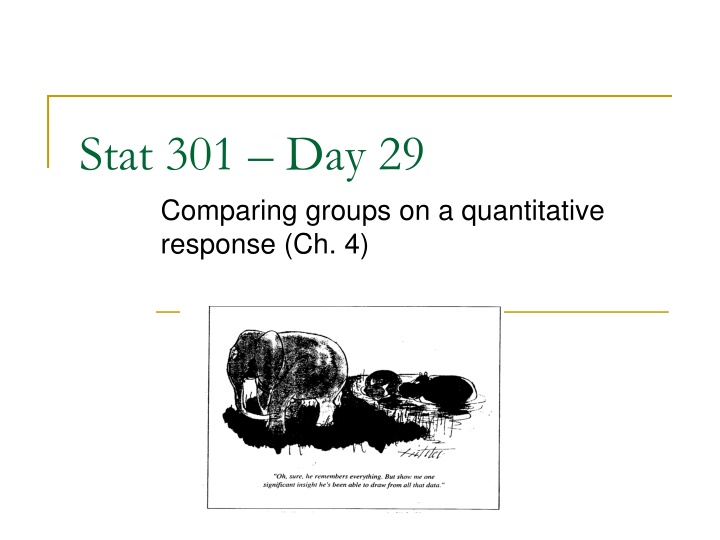
Comparing Groups on Quantitative Response: Statistical Analysis and Inference
This material delves into comparing groups using quantitative data, focusing on appropriate graphs, numerical summaries, statistical significance assessment, and parameter estimation. A specific study on elephants' walking behavior in zoos is explored to illustrate concepts such as random sampling, data reliability, and the implications of study design on drawing conclusions. Practical tools like R and statistical applets are suggested for graphical and numerical comparisons between groups.
Download Presentation

Please find below an Image/Link to download the presentation.
The content on the website is provided AS IS for your information and personal use only. It may not be sold, licensed, or shared on other websites without obtaining consent from the author. If you encounter any issues during the download, it is possible that the publisher has removed the file from their server.
You are allowed to download the files provided on this website for personal or commercial use, subject to the condition that they are used lawfully. All files are the property of their respective owners.
The content on the website is provided AS IS for your information and personal use only. It may not be sold, licensed, or shared on other websites without obtaining consent from the author.
E N D
Presentation Transcript
Stat 301 Day 29 Comparing groups on a quantitative response (Ch. 4)
Ch. 4 Comparing groups on quantitative response What are appropriate graphs to look at? What are appropriate statistics for summarizing the data numerically? Choice of statistic How assess statistical significance? How estimate the corresponding difference in population/ treatment parameter? Factors that affect p-value, confidence Scope of conclusions based on study design
Recap: Investigation 4.1 Comparing the groups using graphs with the same scaling Statistical inference: With small data sets, why not look at all possible arrangements of the observations to groups? Count how many are more extreme than our observed result? Models random assignment Do need to consider what you mean by more extreme Not feasible in moderate to large data sets Doesn t give us a confidence interval
Investigation 4.2 Researchers Holdgate et al. (2016) studied walking behavior of elephants in North American zoos to see whether there is a difference in average distance traveled by African and Asian elephants. They put GPS loggers on 33 randomly selected African elephants and 23 randomly selected Asian elephants and measured the distance (in kilometers) the elephants walked per day.
Inv 4.2 Why might this data be of interest? an assumption that elephants are strongly motivated and physiologically adapted to walk long distances, and that the welfare of zoo elephants is therefore compromised when walking distance is constrained How measure reliably? 49 zoos, simple random sample of two adult females from each zoo (if > 2 eligible) GPS tracking devices, 5 non-consecutive days, at least 20 hours outdoors Calculated mean daily walking distance for 56 elephants across 30 zoos
Use R or applet Graphical and Numerical summaries for comparing two (or more) groups on a quantitative response Briefly answer (b) (h) (b) Don t have to upload but might want to start practicing Ignore comment before Numerical Summaries Tech Detour
Statistical significance? Could a difference this large have happened by chance alone? Need to know how our statistic (difference in sample means) behaves under repeated random samples from two populations Probability detour Salaries (in millions of dollars) of NBA players Two Populations applet Select NBASalaries2021 from pull-down menu
Central Limit Theorem Does this theorem apply with NBA data? Did it successfully predict the behavior of the sampling distribution?
Recap Overall/on average, not much difference between the two populations However, taking 20 from each league, might find a difference in the sample means from random sampling error
Recap Luckily, the distribution of the differences in sample means follows a very predictable pattern Mean: 1- 2 SD: s12/n1 + s22/n2 Approximately normal as populations not too skewed or samples too small Differences in sample means
1000 trials difference in sample means CLT Prediction Approximately normal Center: -0.81 SD: 2.33 Simulation
Recap Which means, when we use the sample standard deviations to calculate the standard error, the standardized statistic will be well- modelled by a t-distribution The appropriate degrees of freedom are a little complicated, but we ll let the computer deal with that
Technology Options Theory-based Inference applet Summary data Raw data (stacked vs. unstacked) R iscamtwosamplet (summary data) t.test(y ~ x, alt = , var.equal = FALSE) (raw data)
To Do Review/Practice Technology Instructions for Two-Sample t-test Start PP 4.2A and PP 4.2B
